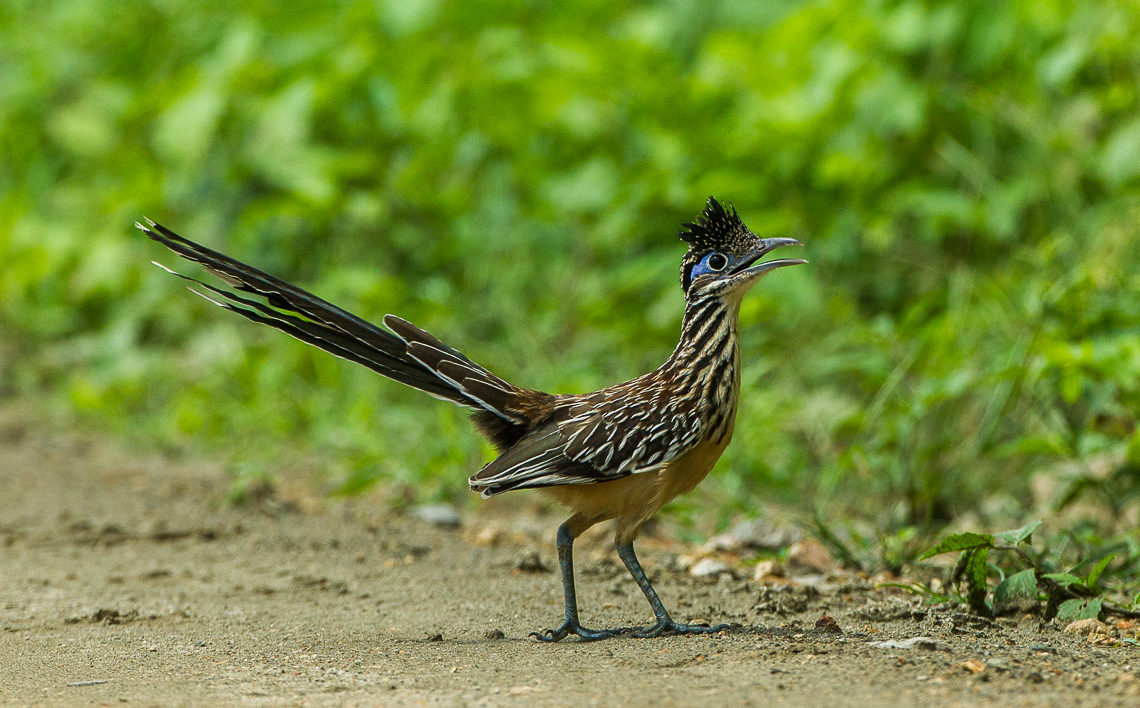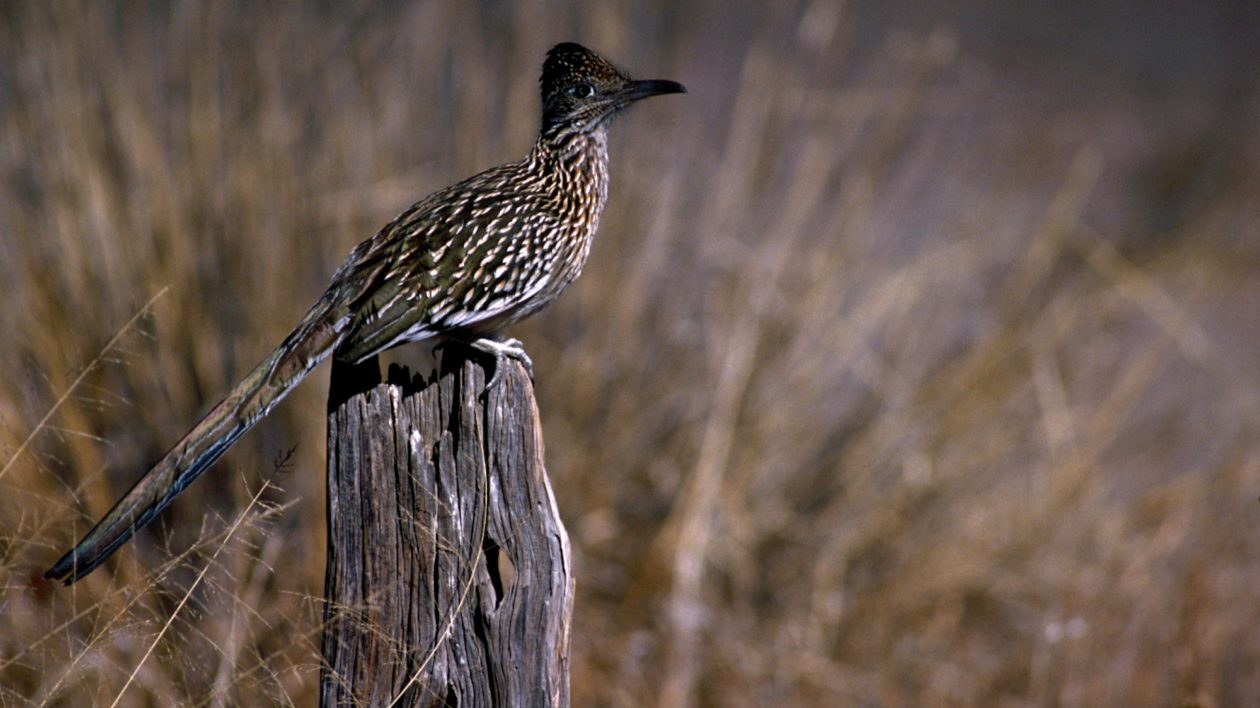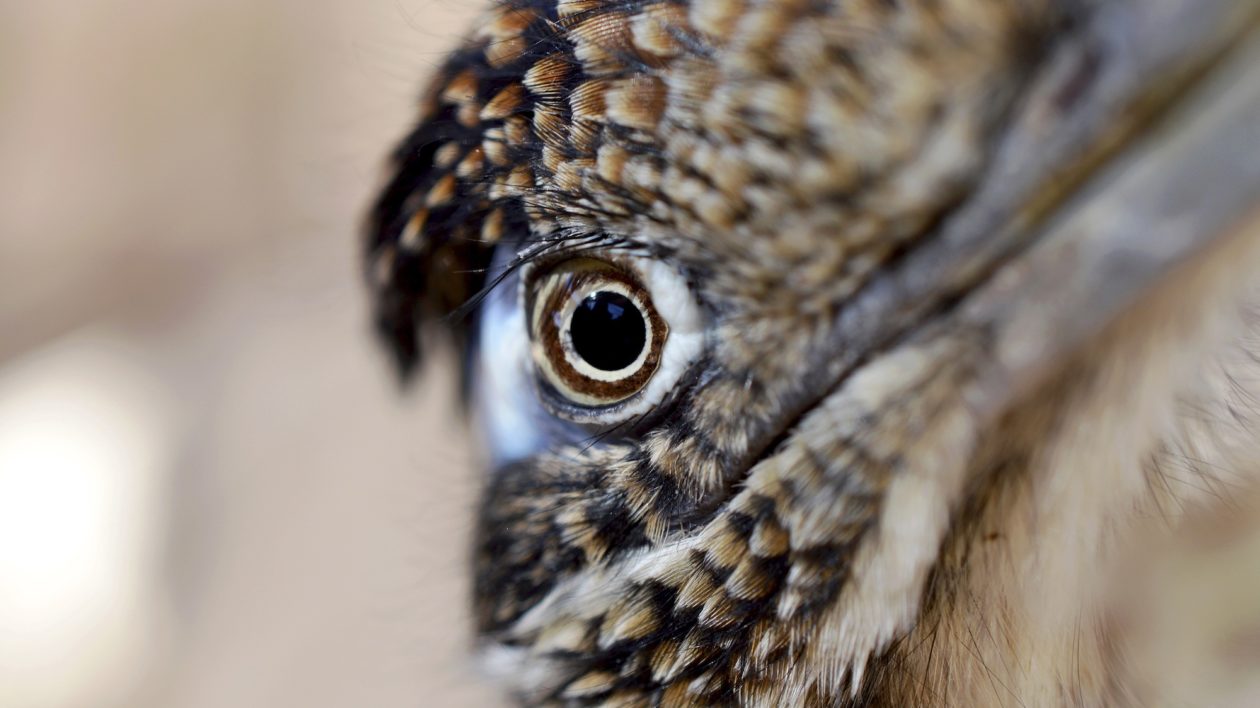Roadrunners don’t say “meep meep!”
They don’t have blue feathers and orange feet. And they don’t outsmart frenetic, bug-eyed coyotes by tricking them into running off cliffs.
None of this should be surprising, because Looney Tunes aren’t exactly known for their accurate depictions of animal species. But the true story of this uncommon bird is more remarkable than anything a Warner Bros animator could dream up.
Greater roadrunners can survive in the desert, run faster than a human, and beat rattlesnakes to death against rocks. Seldom seen and under-appreciated, they’re a bird worth getting to know.
If a Cuckoo Looked Like a Chicken…
They might look like a scrawny chicken, but roadrunners (all one word) are members of the cuckoo family. Their nearest relatives are New World cuckoos, including the yellow-billed and black-billed cuckoos, as well as the smooth- and groove-billed anis. The name of their genus, Geococcyx, translates from Latin to “earth-cuckoo.”
There are just two species: The greater roadrunner (Geococcyx californianus) which ranges from the southwestern and south-central United States down through Mexico, and the lesser roadrunner (Geococcyx velox), found in Mexico and Central America.
The two species look very similar, with striped brown plumage, an upright stance, long legs and tail, and a crest on their heads. Lesser roadrunners have a bright blue patch of skin behind their eye, while on greater roadrunners this skin fades from blue to white to a warm red.

In the United States, roadrunners aren’t common. Most people see them by chance along the road, as they make a mad dash across the asphalt or hunt reptiles basking in the sun. They run in a horizontal position, with their tail held flat and their head and chest tilted forward and down, level with the ground. Roadrunners can’t fly well for long distances, so they limit their flight to short glides or bursts when startled.
Roadrunners tend to avoid forested and urban areas, preferring semi-open, scrubby habitats dominated by creosote, mesquite, chaparral, and tamarisk. They can also be found in grasslands, riparian woodlands and canyon habitats. They are also seen perched on tall shrubs, rocks, and fence-posts, where they sunbathe, call out to potential mates, and survey their territory.
While Looney Tunes’ cartoon roadrunner might have been able to out-run the coyote every time, real-life roadrunners aren’t so lucky. Coyotes can out-pace roadrunners substantially, clocking up to ~43 miles per hour, compared to the roadrunners ~20 miles per hour. Coyotes will prey on roadrunners, and so will raccoons and raptors.
Roadrunners are important figures in both Mexican and Native American culture, where the species is revered for “their courage, strength, speed, and endurance,” according to the Cornell Lab of Ornithology. Cornell also notes that the bird’s X-shaped footprints, with two toes pointing in each direction, “are used as sacred symbols by Pueblo tribes to ward off evil. The X-shape disguises the direction the bird is heading, and is thought to prevent evil spirits from following.”

Leaping on Lizards & Smashing Snakes
Roadrunners feast on a diet of lizards, snakes, small mammals, amphibians, and insects, including venomous scorpions. Their zygodactyl feet — with two toes facing in each direction — help them grip wriggly prey.
No snake is off limits, including rattlesnakes. Greater roadrunners are one of the few animals known to attack rattlesnakes, which they often do in pairs. One bird distracts the snake, bending down with its head towards the ground, tail held vertically, and wings outstretched to either side. Meanwhile, the other bird sneaks up from behind and pins the snake’s head down. The birds then kill the snake by either pecking its head repeatedly, or bashing it against a rock.
Gruesome, yet impressive.
Roadrunners sometimes catch and kill a snake that’s too long for them to swallow all at once. Their solution, according to the Cornell Lab of Ornithology, is to prance about with the snake’s tail hanging out of their mouth, slowly gulping down a few inches at a time as the rest of the snake digests inside of them. They’ll also pre-tenderize lizards and other prey by whacking them repeatedly against a hard surface.
Both species of roadrunner live in harsh desert habitats, and have several adaptations to help them survive with little water. They obtain most of their water from their diet. Like some seabird species, roadrunners have a special gland in front of their eye through which they excrete excess salt. (Think of it like urinating, but with considerably less wasted water.) They also flutter skin beneath their chin, called gular fluttering, to dissipate heat, much like a dog panting.

Cooing and Wooing
Roadrunners have quite the vocal repertoire, making a confusing array of calls that sound like they could come from multiple species. The Cornell Lab describes the male’s call as a series of 3 to 8 downward slurring notes — co-coo-coo-coo-coooooo — which they use to contact mates or mark their territory. Parents will give a low-pitched growl to contact their chicks, or communicate with other birds while forging.
Roadrunners will also bark, much like a coyote, and males make a mechanical putting and whirring sound when courting a female. And birds of all ages and sexes clap their bills together. (You can listen to a variety of roadrunner calls on Xeno Canto.)
Pairs form life-long bonds and reconnect each year with a courtship ritual. During mating, the male jumps onto the female’s back while holding a prey item as an offering. Both birds grasp the carcass in their bills as they copulate, after which the male circles around the female bowing, flicking his tail, and vocalizing repeatedly. The pair then build a nest and raise between two and six chicks.

So the next time you’re driving in roadrunner country, keep your eyes peeled, because you never know when a roadrunner might sprint across your path. It almost certainly won’t be followed by Wile E. Coyote, but it will be an exciting bird sighting.




I live in the Mojave Desert, near Joshua Tree, so I see roadrunners almost daily moseying through my yard.
If seeing one is lucky, my 8 year old daughter is super lucky because she CAUGHT one! It had flown into a fence at the baseball field and she scooped it up and was carrying it under her arm like a chicken. 🤣 I have pictures but can’t post them in comments.